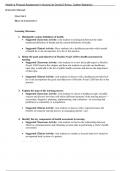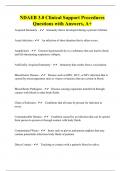(Health & Physical Assessment In Nursing 3e Donita D'Amico, Colleen Barbarito)
(Instructor Manual)
CHAPTER 1
HEALTH ASSESSMENT
Learning Outcomes
1. Distinguish various definitions of health.
• Suggested Classroom Activity: Ask students to distinguish between the older
traditional definition of health and the current definitions of health.
• Suggested Clinical Activity: Have students ask a healthcare provider which model
of health he or she incorporates in to his or her practice.
2. Relate the goals and objectives of Healthy People 2020 to health assessment in
nursing.
• Suggested Classroom Activity: Ask students to review the health topics in Healthy
People 2020 listed in this chapter and then ask students to provide one healthcare
topic they would add to the list of public health concerns and discuss the importance
of that topic.
• Suggested Clinical Activity: Ask students to discuss with a healthcare provider how
he or she incorporates the goals and objectives of Healthy People 2020 into his or her
practice.
3. Explain the steps of the nursing process.
• Suggested Classroom Activity: Ask students to choose a healthcare topic of public
concern and discuss how they will utilize different elements of the nursing process—
assessment, diagnosis, planning, implementing, and evaluation—in assessing that
problem in a community or a population.
• Suggested Clinical Activity: Ask students to discuss with a registered nurse the
benefits of using the nursing process in managing patients’ care.
4. Identify the key components of health assessment in nursing.
• Suggested Classroom Activity: Ask students to discuss the relationship between
effective communications and obtaining accurate data in performing a client’s health
assessment.
• Suggested Clinical Activity: Ask students to conduct a focused interview related to
an impaired body system of a patient.
©2016 by Pearson Education, Inc.
D’Amico/Barbarito, Instructor’s Resource Manual for Health & Physical Assessment In Nursing,
3rd Edition
,5. Explain the role of the professional nurse in health assessment.
• Suggested Classroom Activity: Ask students to discuss the importance of
confidentiality in obtaining a client’s health history.
• Suggested Clinical Activity: Ask students to discuss with a registered nurse the
advantages and disadvantages of using electronic medical documentation.
6. Apply the critical thinking process to health assessment in nursing.
• Suggested Classroom Activity: Ask students to discuss the role of evidence-based
practice in critical thinking.
• Suggested Clinical Activity: Ask students to discuss with a registered nurse his or
her definition of critical thinking and explain how he or she uses critical thinking in
delivering patient care.
7. Outline the key elements of an effective teaching plan.
• Suggested Classroom Activity: Ask students to assume the role of educator and
choose two teaching methods. Compare and contrast the advantages and
disadvantages of these two methods.
• Suggested Clinical Activity: Ask students to list factors and patient considerations
that they must contemplate in developing a health education presentation for a
specific population.
©2016 by Pearson Education, Inc.
D’Amico/Barbarito, Instructor’s Resource Manual for Health & Physical Assessment In Nursing,
3rd Edition
,Key Concepts
1. Changes in healthcare reform continue to impact professional nursing.
2. Nurses’ roles are influential in community health, health promotion, and disease
prevention.
3. Nurses have greater responsibilities beyond the acute care setting including
managing the care of consumers of various ages and diverse communities.
4. Nurses are part of a large group including government, communities, and
individuals capable of improving access to health care and facilitating changes in
the nation’s health.
5. Healthy People 2020 focuses on eliminating preventable health issues in the
United States as well as developing equity of health and health resources.
6. Healthy People 2020 focuses on health promotion, screening, preventive
measures, and improving health behaviors across the life span.
7. The health topics and objectives of Healthy People 2020 focus on both
individuals and communities.
8. Healthy People 2020 encompasses the changing population demographics of the
United States as well as cultural, ethnic, geographic, linguistic, and
socioeconomic factors that affect health.
9. The World Health Organization defines health as a state of complete physical,
mental, and social well-being (1947).
10. The modern definition of health encompasses a holistic approach that includes
physical, psychological, and spiritual components.
11. Wellness reflects a lifestyle that encompasses balance, personal satisfaction, the
ability to cope and adapt, and to enhance one’s quality of life.
12. Health encompasses both wellness and health promotion.
13. Nursing theorists have developed several definitions and models of health that
reflect client holism.
©2016 by Pearson Education, Inc.
D’Amico/Barbarito, Instructor’s Resource Manual for Health & Physical Assessment In Nursing,
3rd Edition
, 14. Nursing strives for a holistic approach to health that reflects physical, cultural,
environmental, psychological, and social factors.
15. Health assessment is systematic data collection from a patient for the purpose of
determining the patient’s health status, assessing health-related risk factors,
identifying health-promoting activities, and identifying health education needs.
16. Health assessment includes the interview, physical assessment, documentation,
and interpretation of findings.
17. Health assessment data collection should be holistic and include physical, social,
cultural, environmental, and emotional factors.
18. Effective communication is a key component in collecting accurate subjective
and objective patient data.
19. The nurse uses knowledge of physical and social science in health assessment
data collection.
20. Thorough and accurate health assessment forms the foundation of the patient’s
plan of care.
21. Level of assessment may differ based on patient status, for example, ambulatory
patients, hospitalized patients, or critical patients.
22. The nursing process is a systematic process used by professional nurses to
manage patients and provide patient care.
23. The nursing process is applicable to individuals, communities, and to varying
populations; to patients of all ages; and is applicable in all levels of health and
stages of illness.
24. The nursing process involves five stages: assessment, diagnosis, planning,
implementation, and evaluation.
25. The nursing process is a complex process that combines critical thinking,
effective communication, and the expansive knowledge base of nursing
education.
26. Effective use of the nursing process is predicated upon comprehensive and
accurate data collection.
©2016 by Pearson Education, Inc.
D’Amico/Barbarito, Instructor’s Resource Manual for Health & Physical Assessment In Nursing,
3rd Edition






